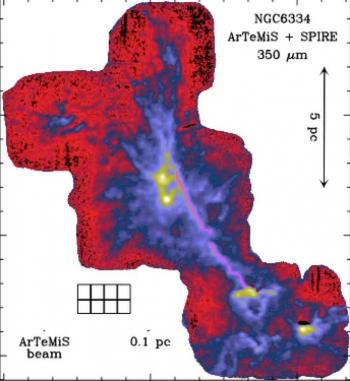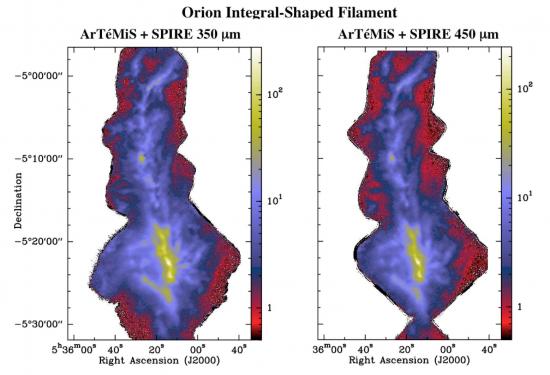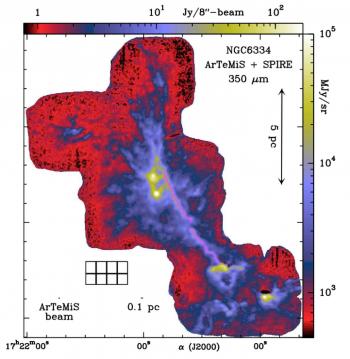The new ArTéMiS submillimetric camera was successfully re-installed in June 2016 on the APEX telescope in the Atacama desert in Chile. In its new configuration, with an increased number of detectors, this camera can simultaneously obtain images at 350 and 450 microns. ArTéMiS produces data with angular resolution more than three times better than that of Herschel satellite at the same wavelengths, and a factor 2 to 3 times better than the LABOCA instrument, also installed on APEX, and which observes at 870 microns. Combining maps obtained at different wavelengths is essential to fully characterize the physical conditions (temperature, density ...) of the dense interstellar matter that forms the stars.
Thanks to its large number of pixels (more than two thousand), and their good sensitivity, ArTéMiS offers an impressive mapping speed, as illustrated above on the maps of the "integral filament" associated with the famous Orion nebula. These maps cover an area of ??nearly one degree of extent and combine accumulated data in just twenty hours of observations with the APEX telescope. ArTéMiS is the only imaging instrument available for these wavelengths in the Southern hemisphere. Access to this instrument is offered to the entire astronomical community through the ESO and OSO calls for proposals.
Characterization of the main filament of the Cat's Paw area with ArTéMiS
The gain in spatial resolution over Herschel makes ArTéMiS a powerful tool for accurately characterizing the structure of interstellar filaments and proto-stars in the massive star-forming regions of our Galaxy.
One of the findings of the Herschel Space Observatory has been to demonstrate that the stars originate primarily in dense filaments. In the nearest interstellar clouds belonging to the Gould belt, such as the Aquila (Eagle) and Taurus (Taurus) regions less than 1,500 light years from the Sun, Herschel has also shown that these filaments have all roughly the same width in the range of only 0.3 light-years. Herschel's results favor a "filamentary paradigm" in which interstellar filaments and pre-stellar dense cores represent two key steps in the process of solar-type star formation.
Herschel's resolving power was nonetheless insufficient to resolve the width of the interstellar filaments observed in the massive star formation regions beyond the Gould Belt as the Cat's Paw Nebula at a distance of about 5500 light years. An important question left open by Herschel was therefore that of the applicability of the filament paradigm to massive star formation regions.
The massive star formation region called NGC 6334, also known as the Cat Paw Nebula, was one of the first regions "photographed" by the 350 micron ArTéMiS camera following the first installation of the instrument on the APEX telescope in the summer of 2013.
The image obtained with ArTéMiS is of a high quality and made the cover of the August 2016 issue of the journal Astronomy and Astrophysics. It made it possible to resolve for the first time the transverse size of the main filament in the NGC 6334 region (indicated in purple in the image below). The detailed analysis of the results, published in the same issue of A & A, showed that the filament width remains approximately constant and about 0.5 light-years in diameter throughout the 30 light-years long filament. This width is very similar to that measured with Herschel for the filaments of the regions of solar-type star formation in the Gould belt.
Although a definitive conclusion will require the study of a greater number of filaments, this first detailed work permitted by the ArTéMiS camera shows that the results obtained with Herschel on the closest filaments are not limited to the low-mass star-forming regions and suggests that the filament paradigm arising from Herschel's observations may be quasi-universal.
Contacts: Philippe ANDRÉ, Vincent REVÉRET, Vera KÖNYVES and Frédéric SCHULLER
Publication:
"Characterizing filaments in regions of high-mass star formation: High-resolution submilimeter imaging of the massive star-forming complex NGC 6334 with ArTéMiS"
Ph. André, V. Revéret, V. Könyves et al. (2016) published in the journal Astronomy & Astrophysics A&A, 592, A54
See also :
- Herschel unravels interstellar filaments (13 April 2011)
- Diving at the heart of the formation of stars with ArTéMiS (September 25, 2013)
- Stars are born in dense filaments (June 6, 2016)
- "From Filamentary Networks to Dense Cores in Molecular Clouds: Toward a New Paradigm for Star Formation" Ph. André, J. Di Francesco, D. Ward-Thompson et al., Review chapter in "Protostars and Planets VI" Arizona Press (2014), p. 27, eds. H. Beuther et al.
For a electronic version: , PDF file
• Structure and evolution of the Universe › Planets, star's formation and dynamics, interstellar medium Structure and evolution of celestial bodies
• Department of Astrophysics (DAp) // UMR AIM
• Spectral-Imagers for Space science • Star Formation and Interstellar Medium
• ArTéMiS







